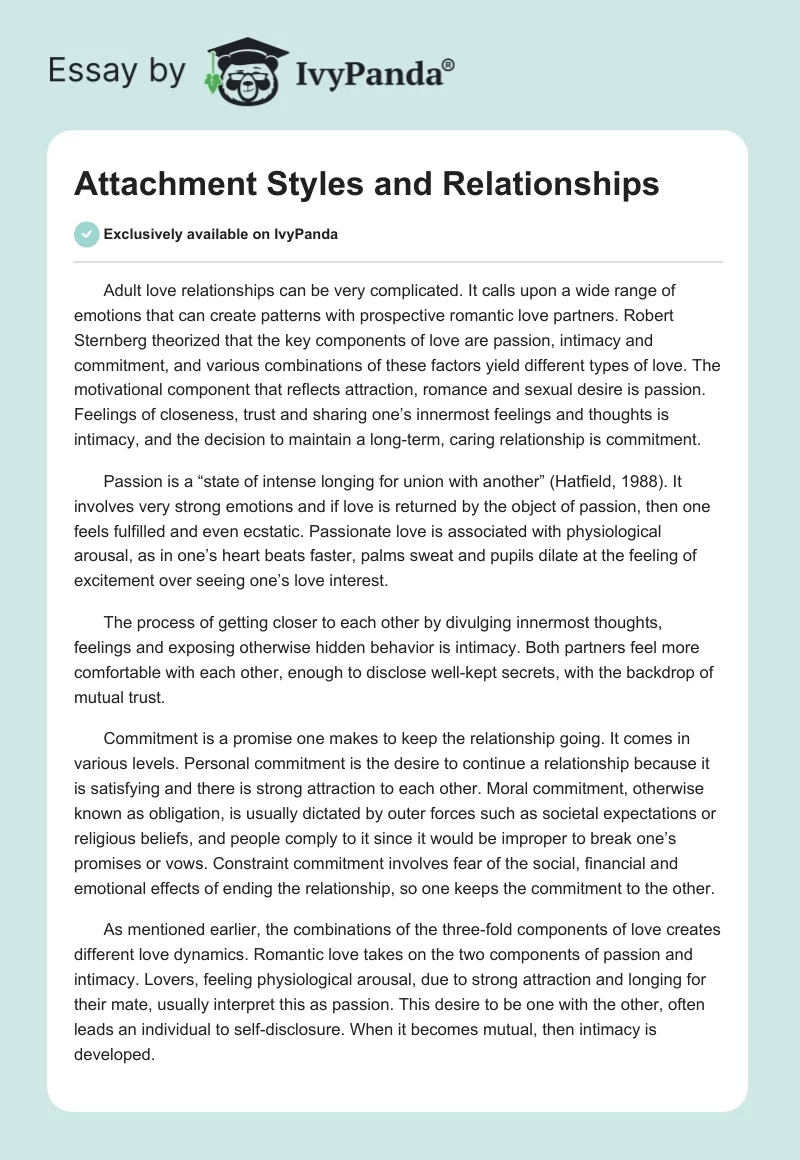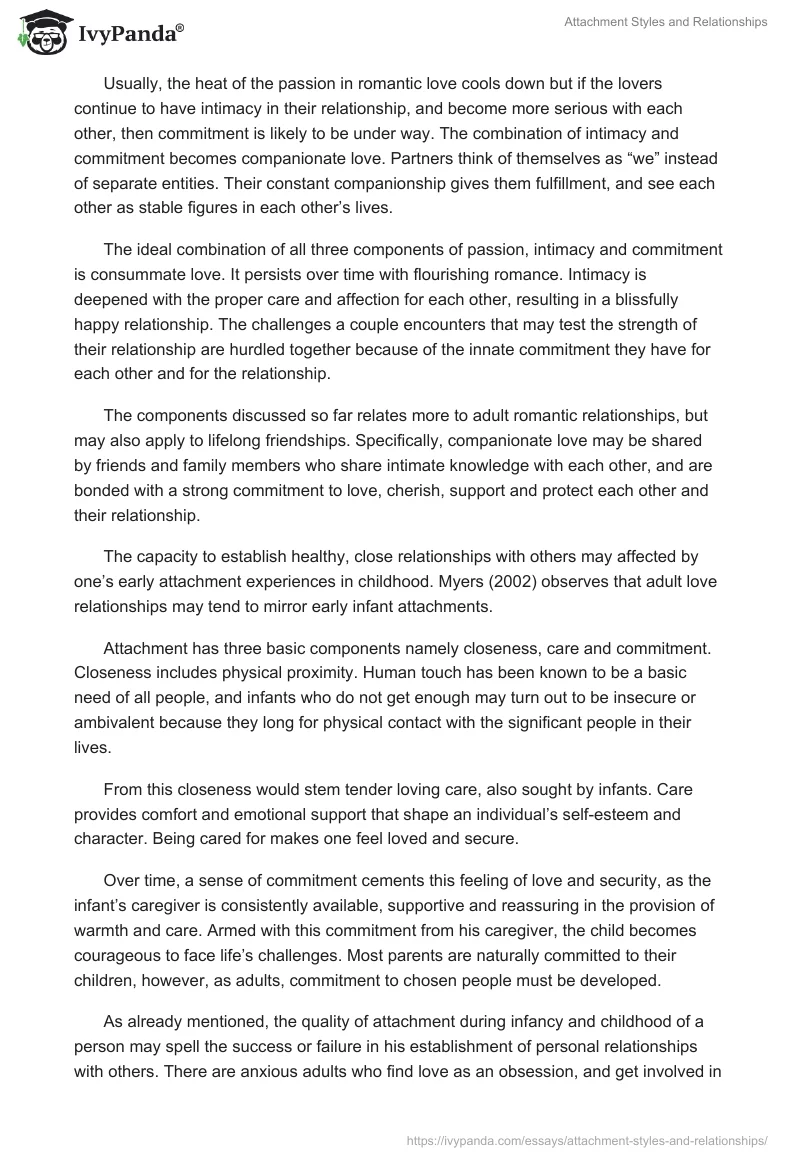Adult love relationships can be very complicated. It calls upon a wide range of emotions that can create patterns with prospective romantic love partners. Robert Sternberg theorized that the key components of love are passion, intimacy and commitment, and various combinations of these factors yield different types of love. The motivational component that reflects attraction, romance and sexual desire is passion. Feelings of closeness, trust and sharing one’s innermost feelings and thoughts is intimacy, and the decision to maintain a long-term, caring relationship is commitment.
Passion is a “state of intense longing for union with another” (Hatfield, 1988). It involves very strong emotions and if love is returned by the object of passion, then one feels fulfilled and even ecstatic. Passionate love is associated with physiological arousal, as in one’s heart beats faster, palms sweat and pupils dilate at the feeling of excitement over seeing one’s love interest.
The process of getting closer to each other by divulging innermost thoughts, feelings and exposing otherwise hidden behavior is intimacy. Both partners feel more comfortable with each other, enough to disclose well-kept secrets, with the backdrop of mutual trust.
Commitment is a promise one makes to keep the relationship going. It comes in various levels. Personal commitment is the desire to continue a relationship because it is satisfying and there is strong attraction to each other. Moral commitment, otherwise known as obligation, is usually dictated by outer forces such as societal expectations or religious beliefs, and people comply to it since it would be improper to break one’s promises or vows. Constraint commitment involves fear of the social, financial and emotional effects of ending the relationship, so one keeps the commitment to the other.
As mentioned earlier, the combinations of the three-fold components of love creates different love dynamics. Romantic love takes on the two components of passion and intimacy. Lovers, feeling physiological arousal, due to strong attraction and longing for their mate, usually interpret this as passion. This desire to be one with the other, often leads an individual to self-disclosure. When it becomes mutual, then intimacy is developed.
Usually, the heat of the passion in romantic love cools down but if the lovers continue to have intimacy in their relationship, and become more serious with each other, then commitment is likely to be under way. The combination of intimacy and commitment becomes companionate love. Partners think of themselves as “we” instead of separate entities. Their constant companionship gives them fulfillment, and see each other as stable figures in each other’s lives.
The ideal combination of all three components of passion, intimacy and commitment is consummate love. It persists over time with flourishing romance. Intimacy is deepened with the proper care and affection for each other, resulting in a blissfully happy relationship. The challenges a couple encounters that may test the strength of their relationship are hurdled together because of the innate commitment they have for each other and for the relationship.
The components discussed so far relates more to adult romantic relationships, but may also apply to lifelong friendships. Specifically, companionate love may be shared by friends and family members who share intimate knowledge with each other, and are bonded with a strong commitment to love, cherish, support and protect each other and their relationship.
The capacity to establish healthy, close relationships with others may affected by one’s early attachment experiences in childhood. Myers (2002) observes that adult love relationships may tend to mirror early infant attachments.
Attachment has three basic components namely closeness, care and commitment. Closeness includes physical proximity. Human touch has been known to be a basic need of all people, and infants who do not get enough may turn out to be insecure or ambivalent because they long for physical contact with the significant people in their lives.
From this closeness would stem tender loving care, also sought by infants. Care provides comfort and emotional support that shape an individual’s self-esteem and character. Being cared for makes one feel loved and secure.
Over time, a sense of commitment cements this feeling of love and security, as the infant’s caregiver is consistently available, supportive and reassuring in the provision of warmth and care. Armed with this commitment from his caregiver, the child becomes courageous to face life’s challenges. Most parents are naturally committed to their children, however, as adults, commitment to chosen people must be developed.
As already mentioned, the quality of attachment during infancy and childhood of a person may spell the success or failure in his establishment of personal relationships with others. There are anxious adults who find love as an obsession, and get involved in unstable relationships because they are not trusting, are demanding of their partner’s reciprocation of their affection and loyalty, and are generally more possessive and jealous. It is common for such people to have grown in an environment where their caregiver has been inconsistent in giving them love and affection, and have developed insecurities due to this. As adults, they become anxious if their partners will be like their caregivers who were not consistent in showing their love. They become afraid that they will be left by their partners the moment they become inconvenient to live with, so they may become clingy and dependent on them.
Some adults exhibit negative, avoidant behaviors towards the people they have relationships with. They are hesitant to emotionally invest in a relationship, as they are uncomfortable getting close to others. For them, it is important to maintain their independence and self-sufficiency, as from infancy, they have learned to fend for themselves, having been raised by cold, unattached caregivers who failed to provide them with the love and security they direly needed.
Adults who are secure do not have any difficulty getting close to others and welcome the opportunity to form personal relationships without fear of being too dependent on other people or being abandoned by them. Their relationships are usually characterized by happiness, trust and friendship. They are more tolerant of their partner’s flaws and faults, and their relationships last long. Such adults may have grown up in warm and responsive homes with early attachments having all three components of closeness, care and commitment.
It is logical to assume that what one gets, one is able to give, especially in relationships. On the other hand, if one has been deprived, then he may have the tendency to be either overly acquisitive and greedy or passively unfeeling and nonchalant. From one’s childhood experiences, a person can learn how his needs are met by the people he grows up with and the quality of attachment he forms with those people. As he grows older, his views are unconsciously echoed with the people he gets into relationships with. His relationship partners need to understand his background and adjust accordingly, just so their relationship will work out fine.
Understanding early attachment patterns of people makes it easier for therapists to pinpoint some problems in relationships. It does not mean that when a person had unfulfilling attachments in childhood that he is doomed to have failed relationships in his lifetime. Of course, scars will be present, but the damage may still be repaired. It is never too late for a person to feel secure in a relationship with a person who is able to ease his past hurts. If this person truly loves the avoidant or anxious partner, she will be patient and understanding enough to provide the closeness, care and commitment that was sorely lacking in his life, growing up. Only then can a more secure attachment be established.
There is much learning to be derived from this. When people in a committed relationship decide to have their own family, it is likely that they may pass on to their offspring the attachment patterns they grew up with.
That is why it is essential that these people reflect back on their childhood and carefully study their individual attachment styles and how it may affect how they raise their future children. In order to raise secure, confident and independent people who will most likely be successful in their personal relationships, parents must give them all the warmth and security that love can give. Children should be assured that their parents will be able to meet all their physical and emotional needs, and are committed to stick with them no matter what. Having dedicated parents as role models to emulate, they will grow up to be nurturing and committed to their partners and offspring as well.


